Macroeconomic Impacts of Climate Change, Climate Adaptation, and Climate Mitigation in Germany
Abstract
1. Introduction
2. Materials and Methods
2.1. Macroeconomic Model PANTA RHEI
2.2. Modeling Approaches for Climate Change, Climate Adaptation, and Climate Mitigation
2.2.1. Climate Change
2.2.2. Climate Adaptation
2.2.3. Climate Mitigation
3. Results
3.1. Impacts of Climate Change (Scenario 2 Compared to 1)
3.2. Impacts of Climate Change and Adaptation (Scenario 3 Compared to 1)
3.3. Impacts of Climate Mitigation (Scenario 4 Compared to 1)
3.4. Impacts of Climate Change, Adaptation, and Mitigation (Scenario 5 Compared to 1)
4. Discussion
5. Conclusions
Supplementary Materials
Author Contributions
Funding
Institutional Review Board Statement
Informed Consent Statement
Data Availability Statement
Conflicts of Interest
Abbreviations
| Bn | Billion |
| CM | Climate mitigation |
| DAS | Deutsche Anpassungsstrategie an den Klimawandel (German Climate Adaptation Strategy) |
| EU | European Union |
| EUR | Euro |
| EW | Extreme weather event |
| EWA | Extreme weather event and adaptation |
| EWACM | Climate change, adaptation and mitigation |
| GDP | Gross domestic product |
| GHG | Greenhouse gas |
| GWS | Gesellschaft für Wirtschaftliche Strukturforschung (Institute of Economic Structures Research) |
| INFORGE | INterindustry FORecasting GErmany |
| IPCC | Intergovernmental Panel on Climate Change |
| NGFS | Network for Greening the Financial System |
| NiGEM | National Institute Global Econometric Model |
| PV | Photovoltaic |
References
- Howarth, C.; Robinson, E.J.Z. Effective climate action must integrate climate adaptation and mitigation. Nat. Clim. Change 2024, 14, 300–301. [Google Scholar] [CrossRef]
- Tröltzsch, J.; Tarpey, J.; Attström, K.; Caspani, M.; Boitier, B.; Le Mouël, P.; Zagamé, P. Macro-Economic/Top-Down Assessment of Climate Impacts on the EU Economy: Final Report; Publications Office of the European Union European Commission: Luxembourg, 2025; ISBN 978-92-68-25698-5. [Google Scholar]
- European Commission. Forging a Climate-Resilient Europe: The New EU Strategy on Adaptation to Climate Change; Impact Assessment Report; European Commission: Brüssel, Belgium, 2021; Available online: https://eur-lex.europa.eu/legal-content/EN/TXT/?uri=COM%3A2021%3A82%3AFIN#document1 (accessed on 20 February 2024).
- Otto, F.E. Attribution of Weather and Climate Events. Annu. Rev. Environ. Resour. 2017, 42, 627–646. [Google Scholar] [CrossRef]
- Hirschfeld, J.; Schulze, N.; Hock, A.-L.; Trenczek, J.; Flaute, M.; Eiserbeck, L.; Sandhövel, M.; Reuschel, S.; Lühr, O.; Hoffmann, E.; et al. Kostendimensionen von Klimaschäden—Eine Systematische Kategorisierung: Studie im Rahmen des Projektes Kosten durch Klimawandelfolgen in Deutschland. 2021. Available online: https://www.ioew.de/fileadmin/user_upload/BILDER_und_Downloaddateien/Publikationen/2022/Hirschfeld_et_al.__2021__Kostendimensionen_von_Klimaschaeden.pdf (accessed on 26 May 2022).
- Nordhaus, W.D. An optimal transition path for controlling greenhouse gases. Science 1992, 258, 1315–1319. Available online: https://www.nobelprize.org/uploads/2018/10/nordhaus-lecture.pdf (accessed on 10 July 2024). [CrossRef]
- Stern, N.H. The Economics of Climate Change: The Stern Review, 30th ed.; Cambridge University Press: Cambridge, UK, 2007; ISBN 9780521700801. [Google Scholar]
- Intergovernmental Panel on Climate Change. Climate Change 2023: Synthesis Report: Contribution of Working Groups I, II and III to the Sixth Assessment Report of the Intergovernmental Panel on Climate Change; Intergovernmental Panel on Climate Change: Geneva, Switzerland, 2023. [Google Scholar]
- Network for Greening the Financial System. Conceptual Note on Short-Term Climate Scenarios: Technical Document; Network for Greening the Financial System: Paris, France, 2023. [Google Scholar]
- Network for Greening the Financial System. NGFS Climate Scenarios: Technical Dokumentation; Network for Greening the Financial System: Paris, France, 2023. [Google Scholar]
- Bender, S.; Groth, M.; Seipold, P.; Gehrke, J.-M. Klimaschutz und Anpassung an die Folgen des Klimawandels: Synergien und Zielkonflikte im Rahmen Kommunaler Konzepte und Strategien. 2022. Available online: https://www.helmholtz-klima.de/sites/default/files/medien/dokumente/gerics_netto-null_repot_anpassung_klimaschutz-final-screen-1_1.pdf (accessed on 2 October 2024).
- Sievers, L.; Grimm, A.; Siegle, J.; Fahl, U.; Kaiser, M.; Pietzcker, R.; Rehfeldt, M. Gesamtwirtschaftliche Wirkung der Energiewende; Potsdam Institute for Climate Impact Research: Potsdam, Germany, 2023. [Google Scholar]
- Umweltbundesamt. Sozio-Ökonomische Folgenabschätzung zum Projektionsbericht 2023. Climate Change 17/24. 2024. Available online: https://www.umweltbundesamt.de/publikationen/sozio-oekonomische-folgenabschaetzung (accessed on 2 October 2024).
- Lutz, C.; Becker, L.; Kemmler, A. Socioeconomic Effects of Ambitious Climate Mitigation Policies in Germany. Sustainability 2021, 13, 6247. [Google Scholar] [CrossRef]
- Philip, P.; Ibrahim, C.; Hodges, C. Germany’s Turning Point: Accelerating New Growth on the Path to Net Zero. 2021. Available online: https://www2.deloitte.com/content/dam/Deloitte/global/Documents/821098-02_Germany%27s-Turning-Point.pdf (accessed on 23 May 2022).
- Flaute, M.; Reuschel, S.; Stöver, B. Volkswirtschaftliche Folgekosten durch Klimawandel: Szenarioanalyse Bis 2050: Studie im Rahmen des Projektes Kosten durch Klimawandelfolgen in Deutschland; GWS Research Report 2022/02; Gesellschaft für Wirtschaftliche Strukturforschung: Osnabrück, Germany, 2022. [Google Scholar]
- Flaute, M.; Reuschel, S.; Lutz, C. Economic Impacts of Exemplary Climate Change and Adaptation Effects Under Different Socio-Economic Developments in Germany. GLCE 2024, 2, 184–192. [Google Scholar] [CrossRef]
- Lutz, C.; Banning, M.; Ahmann, L.; Flaute, M. Energy efficiency and rebound effects in German industry: Evidence from macroeconometric modeling. Econ. Syst. Res. 2021, 34, 253–272. [Google Scholar] [CrossRef]
- Maier, T.; Mönnig, A.; Zika, G. Labour demand in Germany by industrial sector, occupational field and qualification until 2025—Model calculations using the IAB/INFORGE model. Econ. Syst. Res. 2015, 27, 19–42. [Google Scholar] [CrossRef]
- Becker, L.; Bernardt, F.; Bieritz, L.; Mönnig, A.; Parton, F.; Ulrich, P.; Wolter, M.I. INFORGE in a Pocket; GWS-Kurzmitteilung: Osnabrück, Germany, 2022; Available online: https://www.gws-os.com/de/publikationen/gws-kurzmitteilungen/detail/inforge-in-a-pocket (accessed on 27 September 2023).
- Nikas, A.; Doukas, H.; Papandreou, A. A Detailed Overview and Consistent Classification of Climate-Economy Models. In Understanding Risks and Uncertainties in Energy and Climate Policy; Doukas, H., Flamos, A., Lieu, J., Eds.; Springer International Publishing: Cham, Switzerland, 2019; pp. 1–54. ISBN 978-3-030-03151-0. [Google Scholar]
- Ulrich, P.; Naegler, T.; Becker, L.; Lehr, U.; Simon, S.; Sutardhio, C.; Weidlich, A. Comparison of macroeconomic developments in ten scenarios of energy system transformation in Germany: National and regional results. Energy Sustain. Soc. 2022, 12, 35. [Google Scholar] [CrossRef]
- Lutz, C.; Becker, L. Effects of Energy Price Shocks on Germany’s Economy and Private Households. In Vulnerable Households in the Energy Transition: Energy Poverty, Demographics and Policies; Bardazzi, R., Pazienza, M.G., Eds.; Springer: Cham, Switzerland, 2023; pp. 11–28. [Google Scholar]
- AG Energiebilanzen e. V. Bilanzen 1990 Bis 2030. Available online: https://ag-energiebilanzen.de/daten-und-fakten/bilanzen-1990-bis-2030/?_jahresbereich-bilanz=2021-2030 (accessed on 8 May 2025).
- Umweltbundesamt. Kohlendioxid-Emissionsfaktoren für die Deutsche Berichterstattung Atmosphärischer Emissionen. 1990–2023. 2025. Available online: https://view.officeapps.live.com/op/view.aspx?src=https%3A%2F%2Fwww.umweltbundesamt.de%2Fsites%2Fdefault%2Ffiles%2Fmedien%2F361%2Fdokumente%2Fco2_ef_liste_2025_brennstoffe_und_industrie_final.xlsx&wdOrigin=BROWSELINK (accessed on 8 May 2025).
- Box, G.E.P. Science and Statistics. J. Am. Stat. Assoc. 1976, 71, 791–799. [Google Scholar] [CrossRef]
- Colmenares, G.; Löschel, A.; Madlener, R. The rebound effect representation in climate and energy models. Environ. Res. Lett. 2020, 15, 123010. [Google Scholar] [CrossRef]
- Trenczek, J.; Lühr, O.; Eiserbeck, L.; Sandhövel, M.; Ibens, D. Auswahlprozess zur Detailuntersuchung eines Klimawandelbezogenen Extremereignisses: Methodisches Konzept und Anwendung; Projektbericht “Kosten durch Klimawandelfolgen”; Prognos AG: Düsseldorf, Germany, 2022; Available online: https://www.prognos.com/sites/default/files/2022-07/Prognos_KlimawandelfolgenDeutschland_%20Auswahl_Untersuchungsereignisse_AP2_2.pdf (accessed on 7 May 2025).
- Brienen, S.; Walter, A.; Brendel, C.; Fleischer, C.; Ganske, A.; Haller, M.; Helms, M.; Höpp, S.; Jensen, C.; Jochumsen, K.; et al. Klimawandelbedingte Änderungen in Atmosphäre und Hydrosphäre: Schlussbericht des Schwerpunktthemas Szenarienbildung (SP-101) im Themenfeld 1 des BMVI-Expertennetzwerks. 2020. Available online: https://www.bmdv-expertennetzwerk.bund.de/DE/Publikationen/TFSPTBerichte/SPT101.pdf (accessed on 15 June 2023).
- Pfeifer, S.; Rechid, D.; Bathiany, S. Klimaausblick Deutschland. 2020. Available online: https://gerics.de/imperia/md/content/csc/projekte/klimasignalkarten/gerics_klimaausblick_germany_version1.2_deutsch.pdf (accessed on 19 May 2022).
- Peter, M.; Guyer, M.; Füssler, J.; Bednar-Friedl, B.; Knittel, N.; Gabriel, B.; Schwarze, R.; von Unger, M. Folgen des Globalen Klimawandels für Deutschland: Abschlussbericht: Analysen und Politikempfehlungen. 2020. Available online: https://www.umweltbundesamt.de/sites/default/files/medien/376/publikationen/2020-05-06_cc_15-2020_impactchain.pdf (accessed on 19 May 2022).
- Ren, X.; Weitzel, M.; O’Neill, B.C.; Lawrence, P.; Meiyappan, P.; Levis, S.; Balistreri, E.J.; Dalton, M. Avoided economic impacts of climate change on agriculture: Integrating a land surface model (CLM) with a global economic model (iPETS). Clim. Change 2018, 146, 517–531. [Google Scholar] [CrossRef]
- Wang, J.; Vanga, S.K.; Saxena, R.; Orsat, V.; Raghavan, V. Effect of Climate Change on the Yield of Cereal Crops: A Review. Climate 2018, 6, 41. [Google Scholar] [CrossRef]
- Batten, S.; Sowerbutts, R.; Tanaka, M. Climate Change: Macroeconomic Impact and Implications for Monetary Policy. In Ecological, Societal, and Technological Risks and the Financial Sector; Palgrave Macmillan Cham: London, UK, 2020. [Google Scholar]
- de Winne, J.; Peersman, G. The adverse consequences of global harvest and weather disruptions on economic activity. Nat. Clim. Change 2021, 11, 665–672. [Google Scholar] [CrossRef]
- Allen, C.D.; Breshears, D.D.; McDowell, N.G. On underestimation of global vulnerability to tree mortality and forest die-off from hotter drought in the Anthropocene. Ecosphere 2015, 6, art129. [Google Scholar] [CrossRef]
- Buth, M.; Kahlenborn, W.; Savelsberg, J.; Becker, N.; Bubeck, P.; Kabisch, S.; Kind, C.; Tempel, A.; Tucci, F.; Greiving, S.; et al. Vulnerabilität Deutschlands Gegenüber dem Klimawandel; Umweltbundesamt: Dessau-Roßlau, Germany, 2015; Available online: https://www.umweltbundesamt.de/sites/default/files/medien/378/publikationen/climate_change_24_2015_vulnerabilitaet_deutschlands_gegenueber_dem_klimawandel_1.pdf (accessed on 22 May 2023).
- Renner, K.; Fritsch, U.; Zebisch, M.; Wolf, M.; Schmuck, A.; Ölmez, C.; Schönthaler, K.; Porst, L.; Voß, M.; Wolff, A.; et al. Klimawirkungs-und Risikoanalyse 2021 für Deutschland: Teilbericht 2: Risiken und Anpassung im Cluster Land; Umweltbundesamt: Dessau-Roßlau, Germany, 2021; Available online: https://www.umweltbundesamt.de/sites/default/files/medien/479/publikationen/kwra2021_teilbericht_2_cluster_land_bf_211027_0.pdf (accessed on 30 May 2022).
- Lantz, V.; McMonagle, G.; Hennigar, C.; Sharma, C.; Withey, P.; Ochuodho, T. Forest succession, management and the economy under a changing climate: Coupling economic and forest management models to assess impacts and adaptation options. For. Policy Econ. 2022, 142, 102781. [Google Scholar] [CrossRef]
- Tei, S.; Sugimoto, A.; Yonenobu, H.; Matsuura, Y.; Osawa, A.; Sato, H.; Fujinuma, J.; Maximov, T. Tree-ring analysis and modeling approaches yield contrary response of circumboreal forest productivity to climate change. Glob. Change Biol. 2017, 23, 5179–5188. [Google Scholar] [CrossRef]
- Bosello, F.; Standardi, G.; Parado, R.; Dasgupta, S.; Guastella, G.; Rizzati, M.; Pareglio, S.; Schleypen, J.; Boere, E.; Batka, M.; et al. D2.7. Macroeconomic, Spatially-Resolved Impact Assessment: Deliverable of the H2020 COACCH Project. 2020. Available online: https://www.coacch.eu/wp-content/uploads/2020/10/D2.7_final.pdf (accessed on 28 November 2023).
- Alegria, C.; Roque, N.; Albuquerque, T.; Gerassis, S.; Fernandez, P.; Ribeiro, M.M. Species Ecological Envelopes under Climate Change Scenarios: A Case Study for the Main Two Wood-Production Forest Species in Portugal. Forests 2020, 11, 880. [Google Scholar] [CrossRef]
- Dee, L.E.; Miller, S.J.; Peavey, L.E.; Bradley, D.; Gentry, R.R.; Startz, R.; Gaines, S.D.; Lester, S.E. Functional diversity of catch mitigates negative effects of temperature variability on fisheries yields. Proc. Biol. Sci. 2016, 283, 20161435. [Google Scholar] [CrossRef]
- ESKP. Biodiversität und Artenvielfalt. Available online: https://www.eskp.de/grundlagen/klimawandel/biodiversitaet-artenvielfalt-935291/ (accessed on 15 July 2024).
- Tilman, D. Functional Diversity. In Encyclopedia of Biodiversity; Levin, S.A., Ed.; Academic Press: San Diego, CA, USA, 2001; pp. 109–120. ISBN 9780122268656. [Google Scholar]
- Barange, M.; Merino, G.; Blanchard, J.L.; Scholtens, J.; Harle, J.; Allison, E.H.; Allen, J.I.; Holt, J.; Jennings, S. Impacts of climate change on marine ecosystem production in societies dependent on fisheries. Nat. Clim. Change 2014, 4, 211–216. [Google Scholar] [CrossRef]
- Froehlich, H.E.; Gentry, R.R.; Halpern, B.S. Global change in marine aquaculture production potential under climate change. Nat. Ecol. Evol. 2018, 2, 1745–1750. [Google Scholar] [CrossRef]
- Egerer, S.; Puente, A.F.; Peichl, M.; Rakovec, O.; Samaniego, L.; Schneider, U.A. Limited potential of irrigation to prevent potato yield losses in Germany under climate change. Agric. Syst. 2023, 207, 103633. [Google Scholar] [CrossRef]
- Bender, S.; Groth, M.; Viktor, E. Auswirkungen des Klimawandels auf die zukünftige Grundwassernutzung: Betroffenheiten, Handlungsbedarfe und Lösungsansätze. Grund.-Z. Fachsekt. Hydrogeol. (Grund.) 2021, 26, 61–72. [Google Scholar] [CrossRef]
- Fliß, R.; Baumeister, C.; Gudera, T.; Hergesell, M.; Kopp, B.; Neumann, J.; Posselt, M. Auswirkungen des Klimawandels auf das Grundwasser und die Wasserversorgung in Süddeutschland. Grund.-Z. Fachsekt. Hydrogeol. (Grund.) 2021, 26, 33–45. [Google Scholar] [CrossRef]
- Barrage, L. Fiscal Costs of Climate Change in the United States. 2023. Available online: https://ethz.ch/content/dam/ethz/special-interest/mtec/cer-eth/cer-eth-dam/documents/working-papers/wp_23_380.pdf (accessed on 9 June 2023).
- Voß, M.; Kahlenborn, W.; Porst, L.; Dorsch, L.; Nilson, E.; Rudolph, E.; Lohrengel, A.-F. Klimawirkungs-und Risikoanalyse 2021 für Deutschland: Teilbericht 4: Risiken und Anpassung im Cluster Infrastruktur; Umweltbundesamt: Dessau-Roßlau, Germany, 2021; Available online: https://www.umweltbundesamt.de/sites/default/files/medien/479/publikationen/kwra2021_teilbericht_4_cluster_infrastruktur_bf_211027_0.pdf (accessed on 10 April 2024).
- Nilson, E.; Astor, B.; Fischer, H.; Fleischer, C.; Haunert, G.; Helms, M.; Hillebrand, G.; Labadz, M.; Mannfeld, M.; Riedel, A.; et al. Beiträge zu einer verkehrsträgerübergreifenden Klimawirkungsanalyse: Wasserstraßenspezifische Wirkungszusammenhänge—Schlussbericht des Schwerpunktthemas Schiffbarkeit und Wasserbeschaffenheit (SP-106) im Themenfeld 1 des BMVI-Expertennetzwerks. 2020. Available online: https://www.bmv-forschungsnetzwerk.bund.de/DE/Publikationen/TFSPTBerichte/SPT106.pdf?__blob=publicationFile&v=2 (accessed on 24 January 2022).
- Hänsel, S.; Hillebrand, G.; Nilson, E.; Rauthe, M.; Lohrengel, A.-F.; Meine, L.; Herrmann, C.; Brendel, C.; Forbriger, M.; Kirsten, J.; et al. Klimawirkungsanalyse für die Bundesverkehrswege: Methodik und erste Ergebnisse. Schlussbericht des Schwerpunktthemas Klimawirkungsanalyse (SP-102) im Themenfeld 1 des BMVI-Expertennetzwerks. 2020. Available online: https://www.bmv-forschungsnetzwerk.bund.de/DE/Publikationen/TFSPTBerichte/SPT102.pdf?__blob=publicationFile&v=2 (accessed on 10 April 2024).
- Ademmer, M.; Jannsen, N.; Kooths, S.; Mösle, S. Zum Einfluss des Niedrigwassers auf die Konjunktur; Kieler Konjunkturberichte lfW-Box 2018.17; Institut für Weltwirtschaft: Kiel, Germany, 2018; Available online: https://www.ifw-kiel.de/de/publikationen/zum-einfluss-des-niedrigwassers-auf-die-konjunktur-27883/ (accessed on 22 May 2023).
- Ademmer, M.; Jannsen, N.; Mösle, S. Extreme weather events and economic activity: The case of low water levels on the Rhine river. Ger. Econ. Rev. 2023, 24, 121–144. [Google Scholar] [CrossRef]
- Knittel, N.; Jury, M.W.; Bednar-Friedl, B.; Bachner, G.; Steiner, A.K. A global analysis of heat-related labour productivity losses under climate change—Implications for Germany’s foreign trade. Clim. Change 2020, 160, 251–269. [Google Scholar] [CrossRef]
- Wolf, M.; Ölmez, C.; Schönthaler, K.; Porst, L.; Voß, M.; Linsenmeier, M.; Kahlenborn, W.; Dorsch, L.; Dudda, L. Klimawirkungs-und Risikoanalyse 2021 für Deutschland: Teilbericht 5: Risiken und Anpassung in den Clustern Wirtschaft und Gesundheit. 2021. Available online: https://www.umweltbundesamt.de/sites/default/files/medien/479/publikationen/kwra2021_teilbericht_5_cluster_wirtschaft_gesundheit_bf_211027_0.pdf (accessed on 30 May 2022).
- Er-Kara, M.; Ghadge, A.; Bititci, U.S. Modelling the impact of climate change risk on supply chain performance. Int. J. Prod. Res. 2020, 24, 7317–7335. [Google Scholar] [CrossRef]
- Rüttinger, L.; van Ackern, P.; Lepold, T.; Vogt, R.; Auberger, A. Impacts of Climate Change on Mining, Related Environmental Risks and Raw Material Supply. Final Report. 2020. Available online: https://www.umweltbundesamt.de/sites/default/files/medien/479/publikationen/texte_106-2020_impacts_of_climate_change_on_mining_related_environmental_risks_and_raw_material_supply.pdf (accessed on 22 May 2023).
- Karlsson, M.; Ziebarth, N.R. Population health effects and health-related costs of extreme temperatures: Comprehensive evidence from Germany. J. Environ. Econ. Manag. 2018, 91, 93–117. [Google Scholar] [CrossRef]
- Statistisches Bundesamt. Gesundheit: Kostennachweis der Krankenhäuser 2019. Fachserie 12, Reihe 6.3. 2021. Available online: https://www.statistischebibliothek.de/mir/servlets/MCRFileNodeServlet/DEHeft_derivate_00074017/2120630197004.pdf (accessed on 4 July 2025).
- Bobb, J.F.; Obermeyer, Z.; Wang, Y.; Dominici, F. Cause-Specific Risk of Hospital Admission Related to Extreme Heat in Older Adults: Original Investigation. JAMA 2014, 312, 2659–2667. [Google Scholar] [CrossRef]
- Ebi, K.L.; Capon, A.; Berry, P.; Broderick, C.; de Dear, R.; Havenith, G.; Honda, Y.; Kovats, R.S.; Ma, W.; Malik, A.; et al. Hot weather and heat extremes: Health risks. Lancet 2021, 398, 698–708. [Google Scholar] [CrossRef]
- Kjellstrom, T. Impact of Climate Conditions on Occupational Health and Related Economic Losses: A New Feature of Global and Urban Health in the Context of Climate Change. Asia Pac. J. Public Health 2016, 28 (Suppl. S2), 28S–37S. [Google Scholar] [CrossRef]
- Schmuker, C. Klimawandel: Extremtemperaturen Gefährden die Gesundheit. G+G Wissenschaft 21(3). 2021. Available online: https://www.wido.de/publikationen-produkte/ggw-gesundheit-gesellschaft-wissenschaft/ausgabe-3-2021/ (accessed on 22 May 2023).
- Hübler, M.; Klepper, G.; Peterson, S. Costs of climate change: The effects of rising temperatures on health and productivity in Germany. Ecol. Econ. 2008, 68, 381–393. [Google Scholar] [CrossRef]
- Hübler, M. Sozio-ökonomische Bewertung von Gesundheitseffekten des Klimawandels in Deutschland. In Warnsignal Klima: Gesundheitsrisiken—Gefahren für Pflanzen, Tiere und Menschen, 2nd ed.; Lozán, J.L., Graßl, H., Jendritzky, G., Karbe, L., Reise, K., Eds.; 2014; pp. 299–306. Available online: https://www.klima-warnsignale.uni-hamburg.de/wp-content/uploads/pdf/de/gesundheitsrisiken/warnsignal_klima-gesundheitsrisiken-kapitel-4_13.pdf (accessed on 4 July 2025).
- Limaye, V.S.; Max, W.; Constible, J.; Knowlton, K. Estimating the Health-Related Costs of 10 Climate-Sensitive U.S. Events During 2012. Geohealth 2019, 3, 245–265. [Google Scholar] [CrossRef]
- Trenczek, J.; Lühr, O.; Eiserbeck, L.; Leuschner, V. Schäden der Sturzfluten und Überschwemmungen im Juli 2021 in Deutschland: Eine ex-Post-Analyse; Projektbericht “Kosten durch Klimawandelfolgen”; Prognos AG: Düsseldorf, Germany, 2022. [Google Scholar]
- Kemfert, C. Klimawandel Kostet die Deutsche Volkswirtschaft Milliarden; Wochenbericht 11/2007; DIW: Berlin, Germany, 2007. [Google Scholar]
- Kotz, M.; Levermann, A.; Wenz, L. The economic commitment of climate change. Nature 2024, 628, 551–557. [Google Scholar] [CrossRef]
- Mercure, J.-F.; Knobloch, F.; Pollitt, H.; Paroussos, L.; Scrieciu, S.S.; Lewney, R. Modelling innovation and the macroeconomics of low-carbon transitions: Theory, perspectives and practical use. Clim. Policy 2019, 19, 1019–1037. [Google Scholar] [CrossRef]
- International Monetary Fund. Fiscal Monitor: Climate Crossroads: Fiscal Policies in a Warming World; International Monetary Fund: Washington, DC, USA, 2023. [Google Scholar]
- Metcalf, G.E.; Stock, J.H. The Macroeconomic Impact of Europe’s Carbon Taxes. Am. Econ. J. Macroecon. 2023, 15, 265–286. [Google Scholar] [CrossRef]
- Espagne, E.; Oman, W.; Mercure, J.-F.; Svartzman, R.; Volz, U.; Pollitt, H.; Semieniuk, G.; Campiglio, E. Cross-Border Risks of a Global Economy in Mid-Transition; IMF Working Papers 2023/184; International Monetary Fund: Washington, DC, USA, 2023. [Google Scholar]
- Lutz, C.; Reuschel, S.; Stöver, B.; Becker, L.; Kemmler, A.; Eiserbeck, L.; Leuschner, V.; Limbers, J. Szenarien der Gesamtwirtschaftlichen Entwicklung in Deutschland im Kontext von Klimaschutz, Klimawandel und Klimaanpassung: Endbericht zum Forschungsauftrag “Auswirkungen des Klimawandels, des Klimaschutzes und der Klimaanpassung auf Die Gesamtwirtschaftliche Entwicklung in Deutschland (FA 05/22)”; Studie im Auftrag des Bundesministeriums für Wirtschaft und Klimaschutz; GWS mbH: Osnabrück, Germany, 2025; Available online: https://gws-os.com/fileadmin/downloads/endbericht_bmwk_klima_fa0255.pdf (accessed on 9 April 2025).
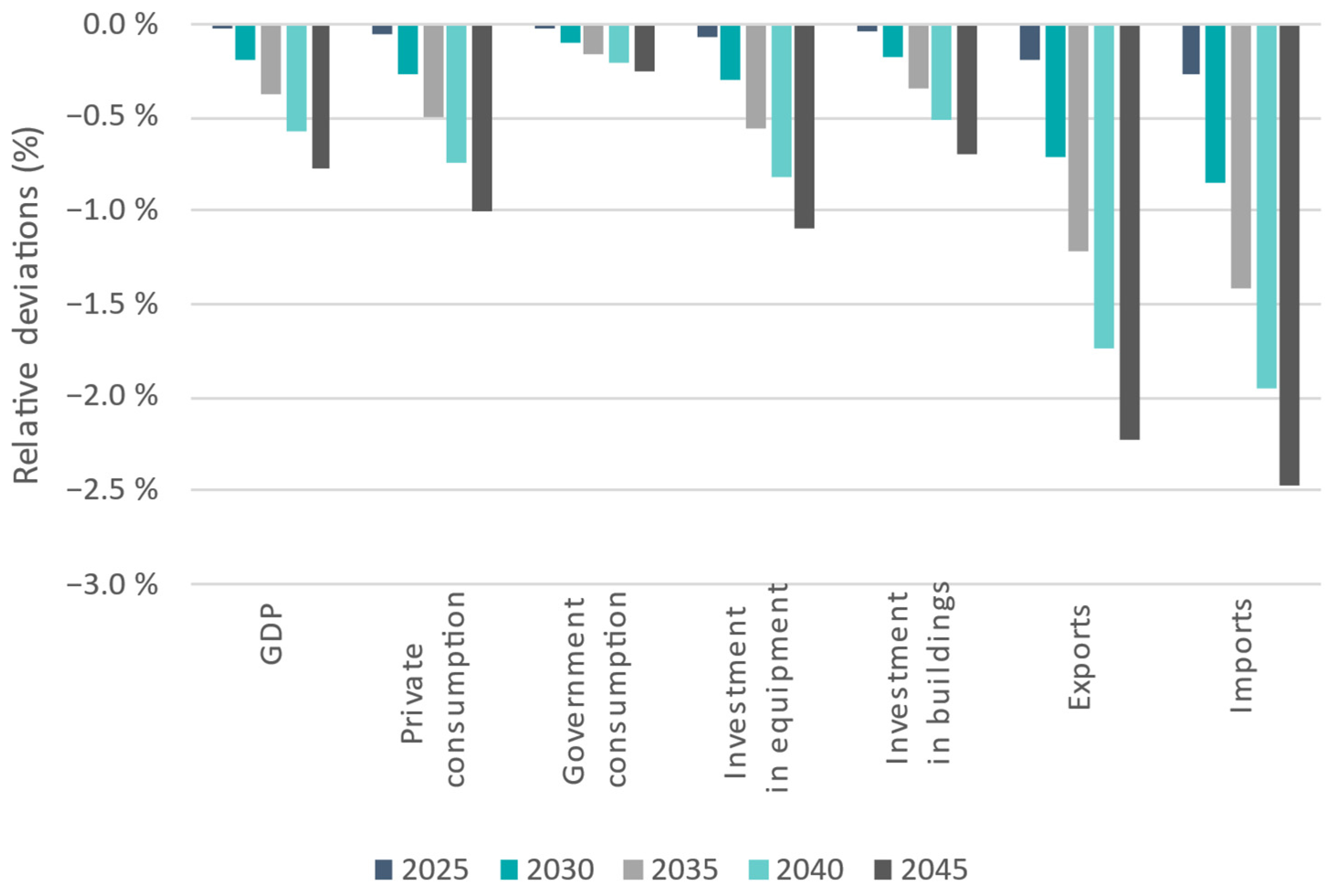
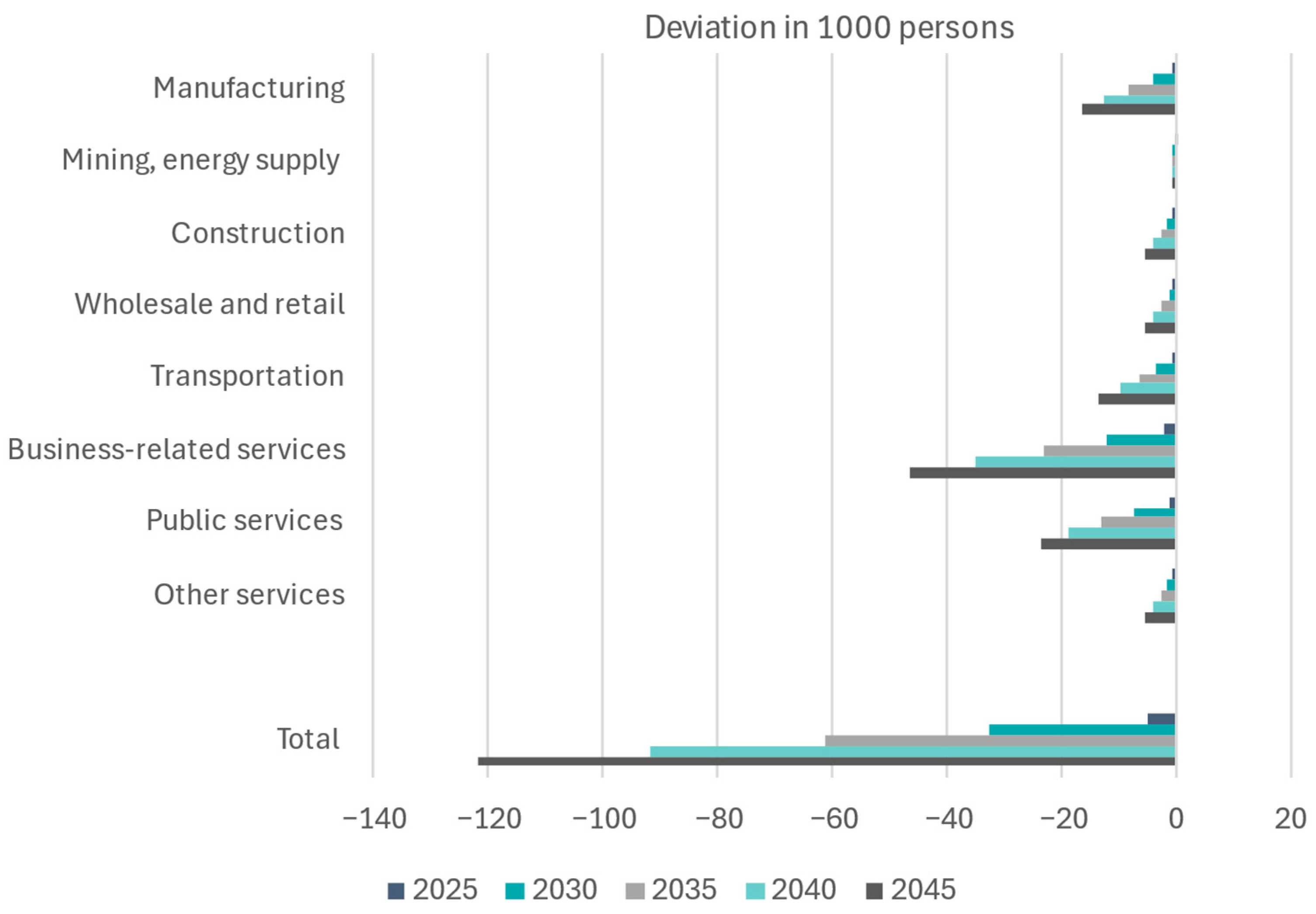
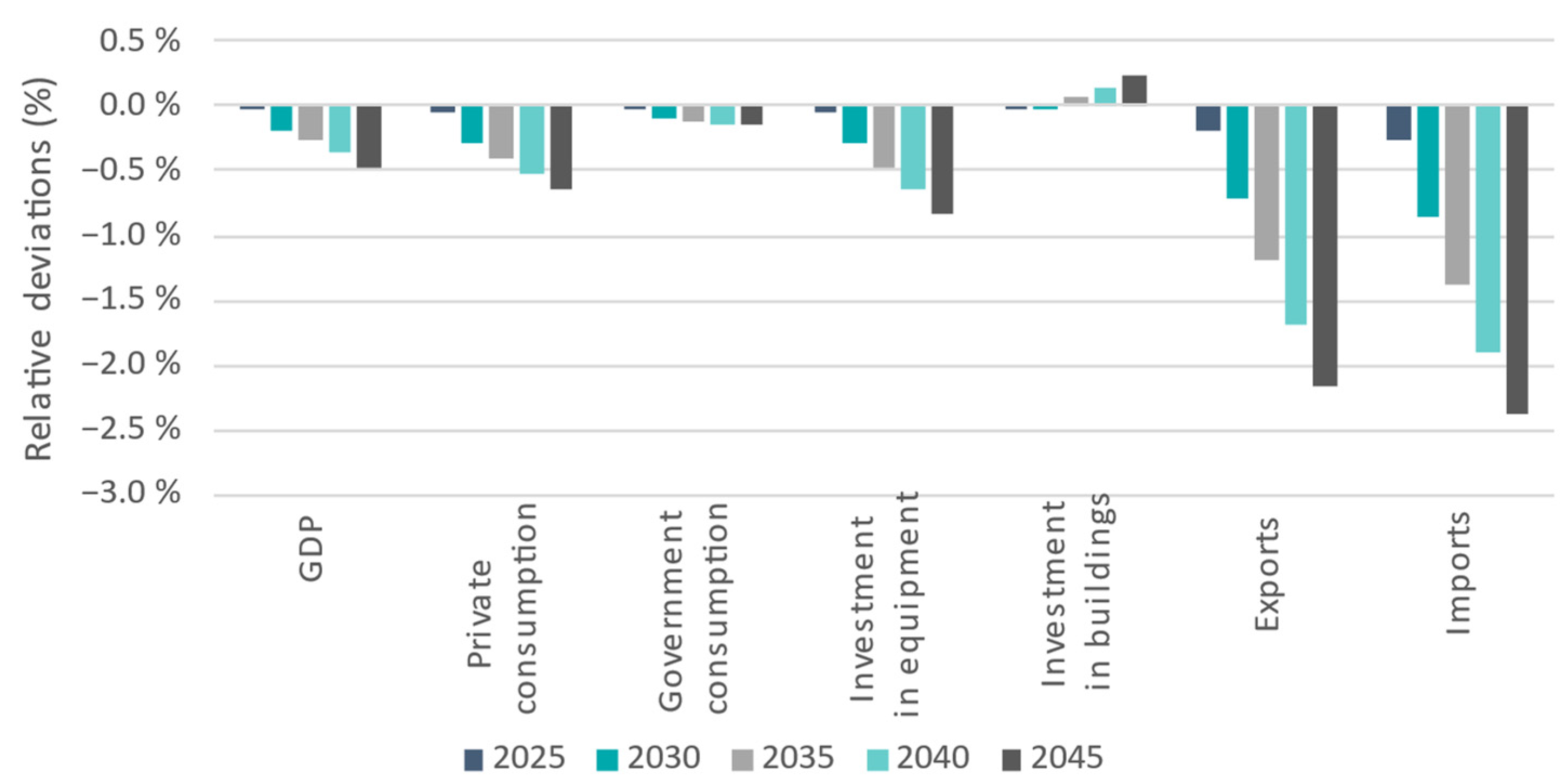
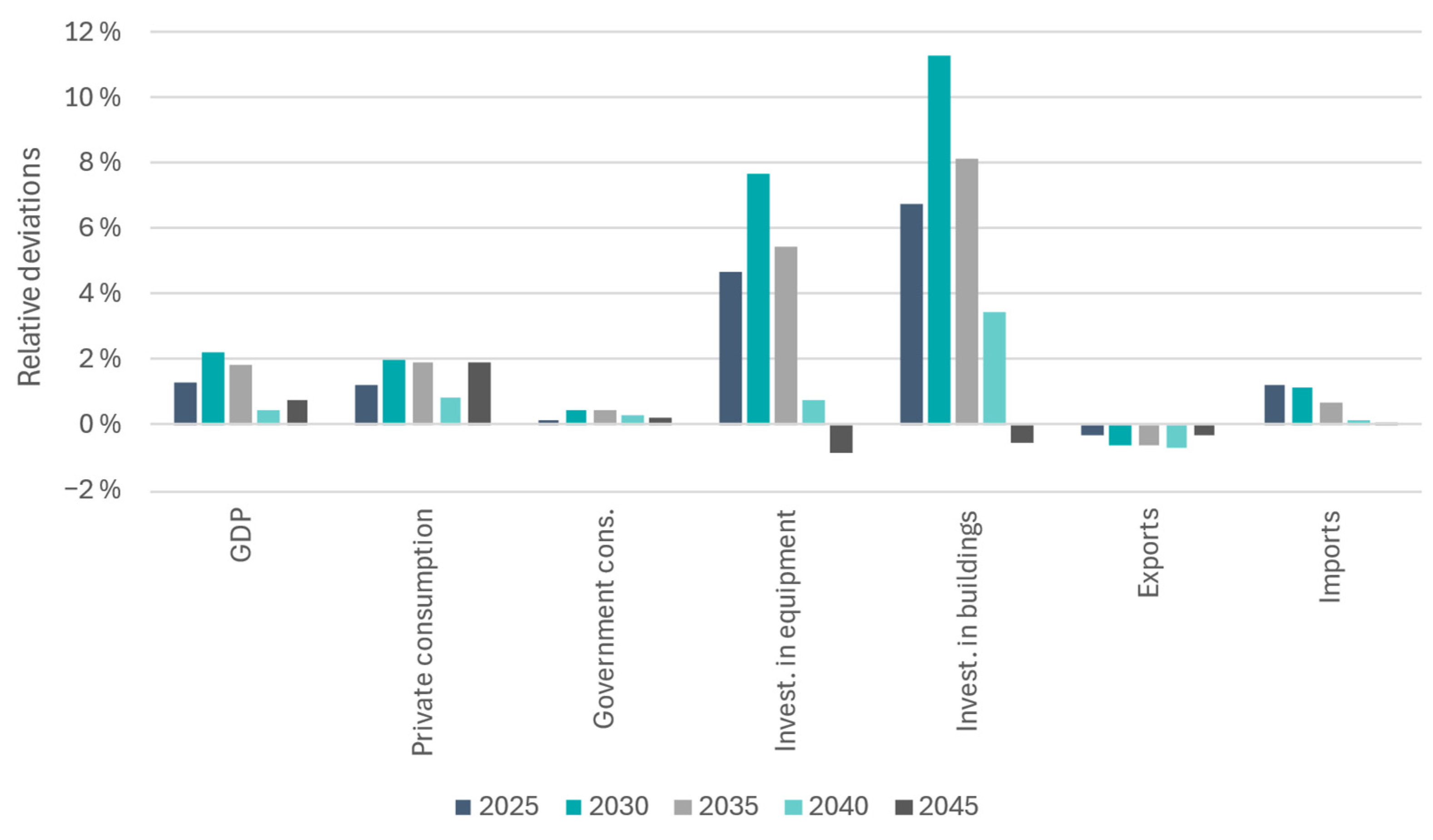
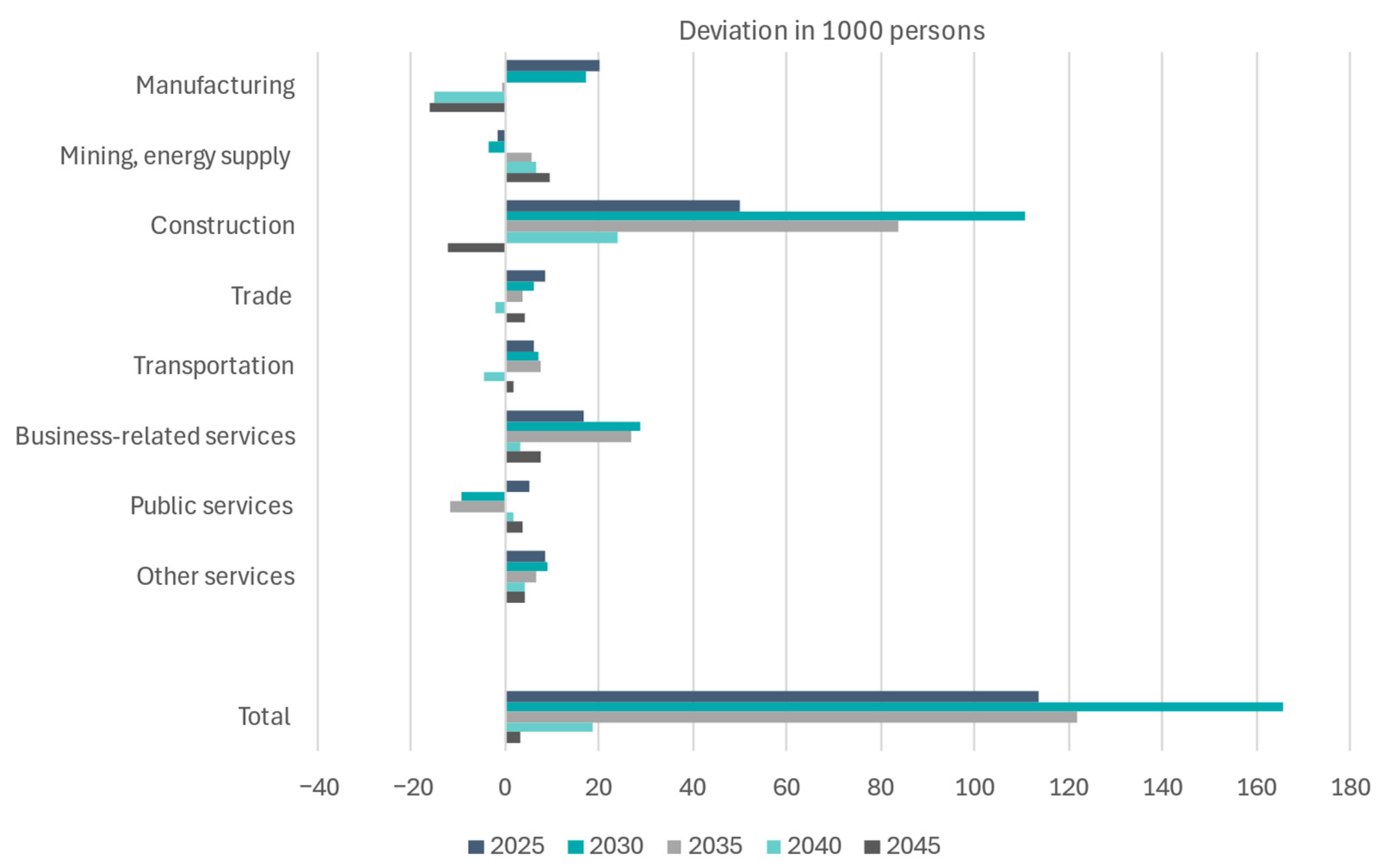
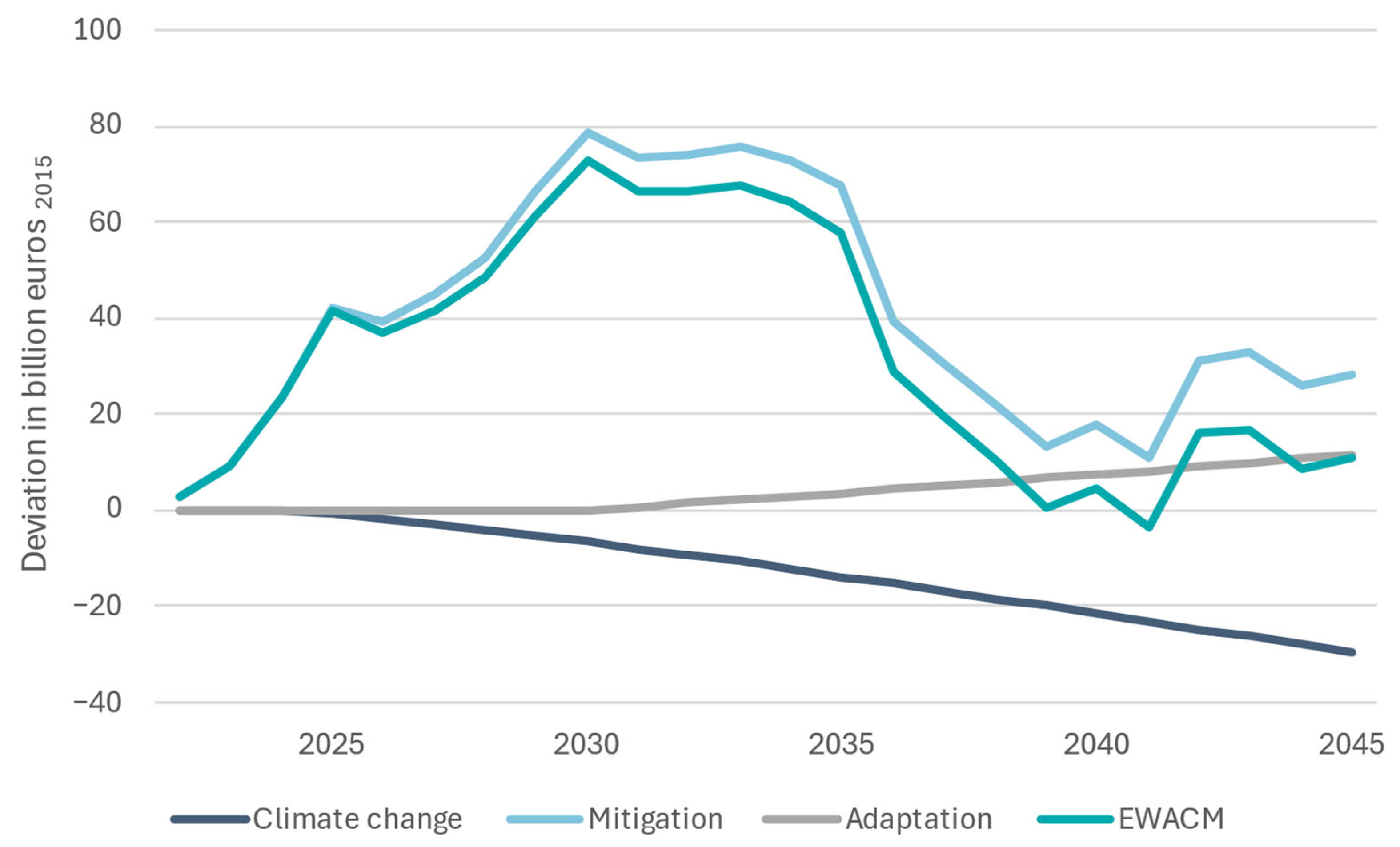
| Scenario | Extreme Weather Events | Mitigation | Adaptation | |
|---|---|---|---|---|
| 1 | Reference | Status 2024 | Policy status 2020 | Policy status 2020 |
| 2 | Extreme weather events (EW) | Yes | Policy status 2020 | Policy status 2020 |
| 3 | EW and adaptation (EWA) | Yes | Policy status 2020 | Yes |
| 3a | Sensitivity of 2 and 3 | Doubled | Policy status 2020 | Yes |
| 4 | Climate mitigation (CM) | Status 2024 | Target achievement | Policy status 2020 |
| 4a | Sensitivity of 4 | Status 2024 | Target achievement (full crowding out) | Policy status 2020 |
| 5 | EW, A, CM (EWACM) | Yes | Target achievement | Yes |
| Field of Action | Climate Hazard and Impact | Parameter | References |
|---|---|---|---|
| Agriculture | Hazard: Heat, drought, heavy rain, flood Impact: Yield losses | Increase in import prices by 20% in 2050 (compared to reference) combined with unchanged import volumes, price increase in food products of 5% (downstream industry), higher rents for agricultural land due to competition for land of 50% in 2050 | [31,32,33,34,35] |
| Forestry | Hazard: Heat, drought, heavy rain, flood, storm Impact: Lower yields | Higher prices of 30% in 2050, price increase in wood products of 8% (downstream industry), doubling of depreciation (broken and damaged timber), higher rents due to competition for land of 50% in 2050 | [36,37,38,39,40,41,42] |
| Fishery | Hazard: Temperature rise Impact: Biodiversity loss, fish diseases, algae, changes in breeding behavior | Increase in import prices by 25% in 2050 | [43,44,45,46,47] |
| Water (management) | Hazard: Heat, drought, heavy rain, flood Impact: Higher efforts to guarantee groundwater quality, functionality of networks and sewage treatment plants | Increase in water demand by 10% until 2050, higher production prices due to +45% more use of electricity, construction measures and administration as well as +30% of engineering services | [48,49,50,51] |
| Navigability of inland waterways | Hazard: Heat, drought Impact: Reduced navigability, impairment of goods traffic | Intermediate input from wholesale services to inland water transport will triple by 2050 to meet delivery obligations | [52,53,54,55,56] |
| International sales markets (industry and commerce) | Hazard: Heat, drought, heavy rain, flood Impact: Disruption of supply chains, lower quantities of goods and higher import prices | Return to the average annual growth rate over last 22 years of import prices for goods in textiles and clothing, printing, chemicals and pharmaceuticals, rubber and plastic products, glass, metal products, electrical equipment, transport equipment and furniture, and repair and installation of machinery and equipment, lowering exports by 0.3% in 2050 | [31,56,57,58,59,60] |
| Buildings | Hazard: Heavy rain, flood Impact: Damage to and destruction of buildings, settlements and infrastructure | Depreciation of insurance industry is 50% higher in 2050, reduction in the lifespan of all buildings by two years and private households’ savings by 15 bn. EUR higher until 2050, companies will increase their depreciation by 0.2% by 2050 | [16] |
| Human health and healthcare system | Hazard: Heat Impact: Heat stress on human health, increase in emergency cases and pressure on healthcare system | Increase in heat-related hospital admissions of 60% by 2050 | [30,51,61,62,63,64,65,66,67,68,69] |
| Field of Action | Adaptation Measure | Implementation Horizon (Years) | Mean Implementation Horizon (Years) |
|---|---|---|---|
| Agriculture | Adaptation to heat waves | 5 | 3.4 |
| Renaturation | 5 | ||
| Measures to increase water efficiency | 1 | ||
| Soil protection through mats | 1 | ||
| Early warning systems and information services | 5 | ||
| Forestry | Adaptation to heat waves | 5 | 3.4 |
| Renaturation | 5 | ||
| Measures to increase water efficiency | 1 | ||
| Soil protection through mats | 1 | ||
| Early warning systems and information services | 5 | ||
| Fishery/international sales markets | - | ||
| Water (management) | Low water protection measures | 5 | 4.2 |
| Adaptation to heat waves | 5 | ||
| Renaturation | 5 | ||
| Measures to increase water efficiency | 1 | ||
| Soil protection through mats | 1 | ||
| Early warning systems and information services | 5 | ||
| Navigability of inland waterways | Low water protection measures | 5 | 5 |
| Early warning systems and information services | 5 | ||
| Buildings | Green roofs | 1 | 6.2 |
| Renaturation | 5 | ||
| Climate-adapted spatial planning | 5 | ||
| Flood protection | 15 | ||
| Early warning systems and information services | 5 | ||
| Human health and healthcare system | Adaptation to heat waves | 5 | 4.2 |
| Renaturation | 5 | ||
| Climate-adapted spatial planning | 5 | ||
| Open space greening | 1 | ||
| Early warning systems and information services | 5 |
| Model | Analysis Period | Damage Costs (Losses in GDP) | Damage Costs p.a. |
|---|---|---|---|
| PANTA RHEI (this study) | 2025–2045 | 2045: −0.8% until 2045: EUR −300 bn | EUR 14.3 bn |
| PANTA RHEI [16] | 2022–2050 | until 2050: EUR −280, −530, −910 bn | EUR 9.7/18.2/31.4 bn |
| D.CLIMATE [15] | 2020–2070 | 2070: EUR −1.2% until 2070: EUR −730 bn | EUR 14.3 bn |
| WIAGEM [71] | 2026–2050 | until 2050: EUR −410 bn | EUR 17 bn |
Disclaimer/Publisher’s Note: The statements, opinions and data contained in all publications are solely those of the individual author(s) and contributor(s) and not of MDPI and/or the editor(s). MDPI and/or the editor(s) disclaim responsibility for any injury to people or property resulting from any ideas, methods, instructions or products referred to in the content. |
© 2025 by the authors. Licensee MDPI, Basel, Switzerland. This article is an open access article distributed under the terms and conditions of the Creative Commons Attribution (CC BY) license (https://creativecommons.org/licenses/by/4.0/).
Share and Cite
Lutz, C.; Becker, L.; Kemmler, A.; Reuschel, S.; Sander, L.; Stöver, B. Macroeconomic Impacts of Climate Change, Climate Adaptation, and Climate Mitigation in Germany. Sustainability 2025, 17, 6175. https://doi.org/10.3390/su17136175
Lutz C, Becker L, Kemmler A, Reuschel S, Sander L, Stöver B. Macroeconomic Impacts of Climate Change, Climate Adaptation, and Climate Mitigation in Germany. Sustainability. 2025; 17(13):6175. https://doi.org/10.3390/su17136175
Chicago/Turabian StyleLutz, Christian, Lisa Becker, Andreas Kemmler, Saskia Reuschel, Lukas Sander, and Britta Stöver. 2025. "Macroeconomic Impacts of Climate Change, Climate Adaptation, and Climate Mitigation in Germany" Sustainability 17, no. 13: 6175. https://doi.org/10.3390/su17136175
APA StyleLutz, C., Becker, L., Kemmler, A., Reuschel, S., Sander, L., & Stöver, B. (2025). Macroeconomic Impacts of Climate Change, Climate Adaptation, and Climate Mitigation in Germany. Sustainability, 17(13), 6175. https://doi.org/10.3390/su17136175






